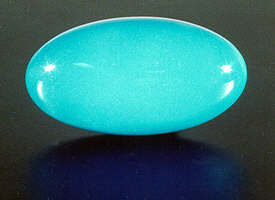Turquoise has a long history as a gemstone. It was one of the favorites of the ancient Egyptians. Its name was derived from the word “Turkish”, which referred to the ancient source of turquoise in present day Iran.
Turquoise will vary in color from pale to medium in any possible combination from sky blue to green. Turquoise may contain visible matrix or webbing.
 |
| Persian quality turquoise Photo by ICA/Bart Curren |
Each source has its favorite color. If you are in Nevada they may charge more for a blue piece with a complex pattern of black lines called spiderweb, in Colorado they may revere the green stuff. The turquoise that commands the highest price per carat on the world market is called Persian turquoise: it is a medium blue color without green secondary colors and has no visible matrix, lines, or other type of flaws in it. At this point fine turquoise is called “Persian quality” meaning it may really come from Arizona but it resembles the fine turquoise that was once mined in Persia, now Iran.
Turquoise prices by the carat are in the low range regardless of quality, but some is really low! In turquoise people generally prefer a certain color and decide whether they like webbing or matrix. So buy what appeals to you, it should all be affordable.
Turquoise is a very porous gemstone. Natural material can easily absorb body oil, soaps, lotions, or other substances and discolor. It will usually turn a brownish green from blue. Consequently a lot of turquoise is stabilized or impregnated. Stabilized turquoise has been infused with a plastic or resin material. Impregnated material has been treated with wax or paraffin. This does two things; it darkens the natural color and it prevents discoloring. Stabilized turquoise is more permanent than the impregnated turquoise. The wax or paraffin could melt if exposed to heat. Some material is also dyed. Dyed turquoise may be hard to distinquish from stabilized material.
Turquoise Gem Properties
| Colors: | Blues to greens |
| R.I.: | 1.61 – 1.65 |
| Durability: | Tough but scratchable |
| S.G.: | 2.60 – 2.90 |
| Treatment: | Stabilization, impregnation and dyeing |
| Hardness: | 5 – 6 |
| Availability: | Adequate supply with a variety of sizes |
| Localities: | Arizona, Nevada, China and Iran |
| Price: | Low |
| Common shapes: | Cabochons in all shapes |
It is easy to test turquoise to see if it is stabilized or impregnated. We can call the test the “shot glass technique”. Simply put an inch or so of clean rubbing alcohol (or gin or vodka as long as it is colorless) in to a colorless shot glass and drop the turquoise into the liquid; if the turquoise darkens in the liquid, it is absorbing liquid and has not been infused with anything. If the stone is not treated the alcohol will quickly evaporate out. Material that has been stabilized or impregnated cannot absorb the alcohol! This really is fun isn’t it?
Natural untreated turquoise with an even medium blue color will command the highest price; it does have the drawback of possible future discoloring. You must decide if you want stabilized or natural material. The natural material may be difficult to find. Ask your seller to write any treatment on the sales slip.
